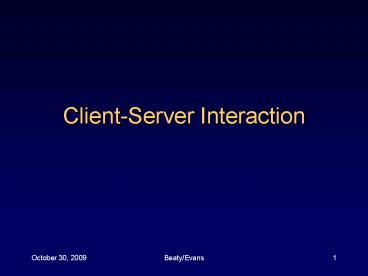ClientServer Interaction - PowerPoint PPT Presentation
1 / 16
Title:
ClientServer Interaction
Description:
Started either at boot or when requested. Typically runs on shared machine. Waits for contact ... memory and CPU plus a good multi-processing OS. 9/16/09. Beaty ... – PowerPoint PPT presentation
Number of Views:34
Avg rating:3.0/5.0
Title: ClientServer Interaction
1
Client-Server Interaction
2
Applications
- Provide high-level services that users interact
with - Provide users with a view of the underlying
network - The only network view users have
- Good dont have to know any details of
underlying networks - Provides naming of resources computers,
services, files, etc. dont have to know
addresses, port numbers, etc. - Key Question how can two application programs on
different machines across the internet
communicate with one another
3
Internet
- Provides communication but says nothing about
what services will be provided - Services left to applications
- Much like telephone system
- Telephone system does not specify voice, data,
FAX, language, etc.
4
Internet Continued
- Phone system also does not initiate
communication, users do - Network cannot know when communication needs to
be initiated, when it needs to be accepted - One end waiting for call, other initiates
- More than one can be waiting on a machine
- For a pair of application programs to
communicate, one must initiate and the other must
accept the request to communicate
5
But, Internet Unlike Phone System in some respects
- There is no general alerting mechanism for all
applications - Instead of waiting for an arbitrary message to
arrive, an application program must interact with
protocol software (PS) and tell it specifically
what type of message it is waiting for, and then
it must wait - Later, if a message of that type arrives, the PS
tells the waiting application passing it the
message - So, one end waits (once registered with its PS),
the other end sends and the sender assumes
receiver (server) is waiting
6
Client/Server
- Server waits, client initiates
- Client is an application software program
- Actively initiates contact temporarily, also
performs computations locally - Only a single session/user
- Can contact multiple servers
- Usually runs locally on a PC
7
Client/Server Continued
- Server is an application software program
- Started either at boot or when requested
- Typically runs on shared machine
- Waits for contact
- Special purpose code that can talk to multiple
clients, but is dedicated to providing a single
service - Is not a type of hardware system but usually
runs on a computer with enough resource capacity - Is a piece of software
8
Client/Server Picture
9
Extra Points About Client-Server
- Must distinguish between server and server-class
computer (server machine) - C-S allows for bi-directional communication
- One client-to-server request can stimulate
multiple server-to-client responses (think of
file servers) - C-S can use either connection oriented or
connectionless transport level (layer 4) service - Typically TCP or UDP
- Regardless client needs to pinpoint server
machine IP address and service identifier to
initiate request
10
Multiple
- Can have multiple servers on single server
machine - Server machine can also have multiple clients
- Usually one server program for each service
offered - Need sufficient memory and CPU plus a good
multi-processing OS
11
Services
- With multiple services, how are each identified?
- TCP uses 16-bit numbers call port numbers
- Each has associated protocol and server
- Server program tells PS which port it is waiting
on then waits - Client specifies which remote port and IP address
to connect to
12
Concurrency
- Example How File Server needs multiple threads
- One thread to handle requests for service and
multiple threads to carry out individual service
work top one client - Server typically has more than one thread of
execution like multiple independently running
subprograms all inside one big program - One to answer call and create new thread to
service request - One thread per client request typical
- New clients dont wait for others to finish
13
Concurrency Continued
- Each client differentiated by source address and
port
14
Server Machine
Server Application Program
S - Server main Thread Answering calls
Port 25
Client C2 Machine
Client C1 Machine
S1 Server Thread to Talk to C1
Source port 4000
Source port 5000
S2 Server Thread to Talk to C2
Client C2
Client C1
IP Address 120.83.6.4
IP Address 185.12.14.2
IP Address 140.23.8.64
Internet
15
Steps of Two-client Interaction
- C1 first asks to set up TCP connection to port 25
on machine 140.23.8.64 - 25 Server S responds and C1-S now has a
connection - S starts a child thread S1 to talk to C1 and S
passes the connection to C1 off to S1. Now C1-S1
connected. - S1 and C1 talk over connection to service C1s
request - S is now free to talk to other clients (while S1
talks to C1) - Now C2 asks to set up a connection to port 25 on
machine 140.23.8.64 - 25 Server S responds and C2-S now has a
connection - S starts a child thread S2 to talk to C2 and S
passes the connection to C2 off to S2. Now C2-S2
connected. - S2 and C2 talk over connection to service C2s
request
16
Steps of Two-client Interaction - continued
- When S1 sends messages to C1 it sends to IP
address 185.12.14.2 and port 4000 - When S2 sends messages to C2 it sends to IP
address 120.83.6.2 and port 5000































